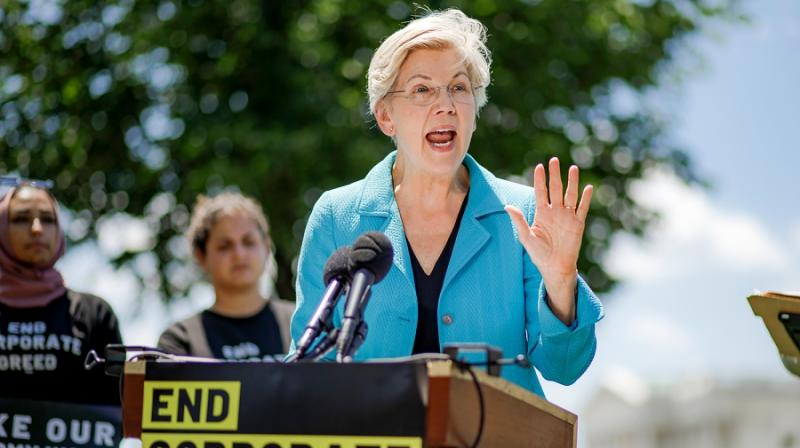Where's the progressive plan to fix government?
By: Will Marshall, Opinion Contributor (MSN)


The political left is completely, totally, utterly clueless. Do Democrats really believe Trump's political rallies were packed because of his rock star celebrity, his name recognition, his eloquence, his power of persuasion? Is that why Democrats are spending political donations and giving support to 'election deniers' in the Republican primaries?
The political left have devoted themselves to reshaping society using a government that is dysfunctional. The Federal bureaucracy is devoting more effort and resources to sustaining itself rather than addressing national problems. Every new program created by Democrats results in more bureaucracy with new agencies, offices, and bureaucratic titles. The bureaucracy provides politicians deniability, political cover, and an endless need for oversight to create the appearance of doing something useful.
Democrats delude themselves into thinking that Bill Clinton reinvented government. That's a blatant falsehood. Bill Clinton privatized government, replacing government employees with private contractors. Clinton created the GOCO government; government owned - contractor operated. Clinton only shrank the size of the Federal workforce; Clinton did not address bureaucratic bloat and bureaucratic dysfunction. Clinton's reinvented government was even less able to address national problems and work for the benefit of local communities. A privatized government only needed more oversight which appeared to be doing something useful without accomplishing anything meaningful.
When 68 pct of people believe government reform is needed then more 'bread and circuses' politics won't change their minds. In fact, the dysfunctional churn in today's politics only reinforces public distrust and dissatisfaction with government. There isn't any leadership in government, no one is in charge, and everyone in government is blaming each other for the dysfunction they have created. The status quo has become dysfunction in government. That's why Trump won the 2016 election on a promise to change the status quo.
Today's divisive politics is actually a battle between a status quo of dysfunction within government and a public demand for government reform. The public demand and expectation for government reform is even tearing apart both political parties. Pandering promises and plans aren't enough any longer. The public is demanding results.

More than 100 election deniers have won Republican primaries across the country this year. It's a woeful reminder that former President Trump's seditious assault on U.S. democracy didn't end with his followers' failed coup attempt on Jan. 6, 2021.
This ominous trend makes the midterm elections much more than a referendum on President Biden's job performance. But Republican extremism isn't the only threat to our democracy.
A more subtle but corrosive danger is nosediving public confidence in the federal government's ability to function effectively. According to the Pew Research Center, only 19 percent of Americans say they trust Washington to do the right thing "most of the time." That's near the historic low point in public confidence since Pew started measuring it in 1958.
At the same time, solid majorities of Americans believe government should play a "major role" in tackling national problems. Their qualms about government are practical, not ideological; centering more on its performance than its size.
Paul Light of the Brookings Institution, a leading expert on public attitudes toward government, reports that demand for "very major" reform of government is at a 20-year high, rising from just 37 percent in 1997 to 60 percent today.
Light sorts voters into four groups with distinct perspectives on government. The largest (44 percent) is "dismantlers," who favor smaller government and big changes in how it operates. "Rebuilders" (24 percent) want bigger government but share the dismantlers' desire for major government reform.
"Expanders" (24 percent) are most enthusiastic about bigger government and less interested in reform. "Streamliners" (10 percent), want smaller government and only some reform.
These numbers indicate that a modest majority of U.S. voters now lean toward smaller government, while a more substantial majority favors big reforms of government.
They help to explain why the progressive left's dreams of "bold, transformative" government action keep smashing on the political rocks. Progressives are full of ideas for expanding government but have no plan for fixing government.
That leaves them unable to allay public doubts that Washington has the capacity to efficiently manage federal agencies, much less run a health care sector that absorbs 20 percent of GDP; rebuild the U.S. economy to the specifications of the Green New Deal; bring back traditional manufacturing jobs; and massively redistribute wealth to abolish inequality and poverty.
Even last year's Build Back Better debacle has done little to dent the left's unbounded faith in the federal government's redemptive powers. Recently there have been calls to nationalize oil companies, even as gas prices come down, and Sen. Elizabeth Warren (D-Mass.) is pushing a bill to empower the IRS - which can't even answer citizens' calls - to do everyone's taxes for them.
"Trust in the federal government is unlikely to rebound without significant reform," says Light. Republicans are making the problem worse by stoking "deep state" paranoia. Because Democrats of all stripes believe in in active government, it falls to them to offer leery voters credible ideas for making it work better.
That begins with honest acknowledgement of underperforming public sector systems and bureaucratic dysfunction.
Public schools are a good example. Many parents are deeply frustrated with central school district bureaucracies and teachers' unions, which kept schools closed for too long during the pandemic, failed to communicate clearly with families and have yet to figure out how to offset students' steep learning losses.
The moment is ripe to press for a sweeping reinvention of our legacy K-12 system aimed at making schools more nimble, autonomous and accountable to parents. But Democrats mostly line up with districts and unions in defending the status quo.
What Light calls the steady "thickening of government" has made the federal government less agile and responsive to citizens. A striking example is the growth of presidential appointees, from 2385 in President Clinton's second term to 5,000 in the Biden administration. Adding "layers of leaders" with portentous titles (like "associate principle deputy assistant secretary") further paralyzes government by fragmenting decision making authority.
The Progressive Policy Institute has documented the related problem of "regulatory accumulation" — the constant layering of new rules upon old. Since Washington lacks politically viable ways to get rid of obsolete, duplicative or conflicting regulations, citizens and businesses are left to hack through an ever-growing thicket of rules.
President Biden's greatest domestic accomplishment to date is passing the landmark $1.3 trillion infrastructure bill. Yet it takes way too long to build things in the United States. As Philip Howard of Common Good has documented, endless regulatory reviews, public hearings and court appeals mean long and costly delays in building new roads, ports, railways and wastewater systems.
Environmental reviews of new projects can grind on for more than a decade. Germany and Canada put time limits (usually two years) on such reviews to force bureaucratic action. Both do at least as good a job protecting the environment as we do. Why can't our federal and state governments impose similar deadlines?
The Biden administration seems to be edging in this direction, but the last Democratic president to take government reform seriously was Bill Clinton. The Clinton-Gore reinventing government initiative ("Rego") actually shrunk the federal bureaucracy, trimmed layers of managers and obsolete rules, and used financial incentives to challenge big federal agencies to boost their productivity.
More fundamentally, Clinton proposed radical changes aimed at making big public sector systems work. He balanced the federal budget, replaced a dependency-fostering welfare system with one that rewarded work and championed public-school choice to give low-income and minority families alternatives to failing urban schools.
Public confidence in government stopped falling and actually rose sharply toward the end of Clinton's term.
What Democrats need today is a Rego redux — a comprehensive blueprint for arresting the erosion in "state capacity." It should harness the power of IT to modernize major public sector systems, making them nimbler, less rulebound and more performance-based.
It's also time for a serious push to decentralize decisions and resources to local government leaders, who enjoy the highest levels of public trust. Above all, we need to free public servants from the process-oriented constraints that keep them from exercising their authority and making common-sense decisions.
So, Democrats need a two-pronged strategy to defend U.S. democracy. First, stop Trump and his minions from sabotaging U.S. elections; second, start reviving Americans' confidence in their government's ability to help them solve their problems.







A government that is broken has no value. Either fix it or get rid of it.